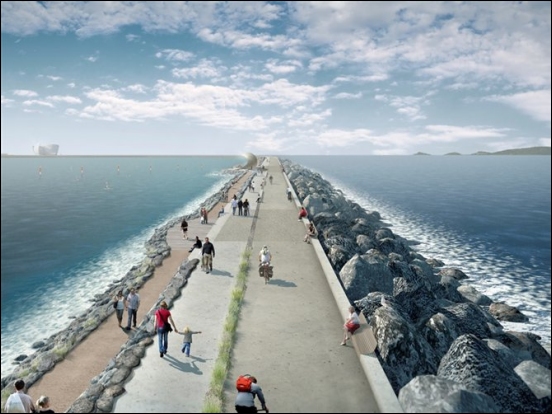The prospect of a Bridgwater Bay lagoon being constructed in the sea near Burnham-On-Sea has been given a major boost this week.
It comes after plans for a £1.3bn tidal lagoon in Swansea Bay to generate power have been backed by a government-commissioned review.
Former Energy Minister Charles Hendry’s independent report into the technology’s viability said it would make a “strong contribution” to the UK’s energy supply and would bring “significant economic opportunity”.
There are hopes of developing a network of larger lagoons around the UK’s coastline, including one in Bridgwater Bay in the Bristol Chanel off Burnham-On-Sea, harnessing power from the ebb and flow of the tides.
Burnham-On-Sea.com has previously reported how a Bridgwater Bay tidal lagoon could protect Burnham from flooding in the event of storms. However there are local concerns that a lagoon could have a negative impact on amount of silt in the estuary and on sand quantities along beaches at Burnham, Brean and Berrow.
Mr Hendry concluded that tidal lagoons would prove more cost-effective over 60 years than other forms of electricity generation such as offshore wind and nuclear power plants, although they would be more expensive in the earlier years.
A proposed 320 megawatt pilot project in Swansea Bay, which was awarded planning permission by Amber Rudd, former energy minister, in June 2015, has a projected lifespan of 120 years. The project would involve building a six-mile horseshoe-shaped seawall with underwater turbines that would enclose part of the bay.
The reports says that the Swansea lagoon scheme could cost households on average an extra 35p-45p a year through their energy bills in the first 15 years, and between 20p-30p when the scheme has been in existence for between 30 and 60 years. Electricity generated after 60 years would be “subsidy free”, he added.
Former UK Energy Minister Mr Hendry has been gathering evidence for nearly a year for his independent inquiry, including visits to all the potential sites and discussions with industry.
The Swansea Bay project would involve 16 turbines along a breakwater but is seen as only the start – a prototype for much larger lagoons.
Tidal Lagoon Power, the company behind the Swansea Bay proposal, says it ‘fleet’ includes one off the coast of Cardiff – east of where Cardiff Bay is now – Newport, Bridgwater Bay, Colwyn Bay and west Cumbria, north of Workington.
Mr Hendry has recommended that no large projects should go ahead before the Swnasea lagoon has been up and running as a trial for at least a year. Meanwhile, a National Policy Statement identifying further suitable sites for development should be set out by government to give confidence to potential investors in the technology, he says.
Meanwhile, The Royal Society for the Protection of Birds, which has opposed other renewable energy schemes because of their impact on bird habitats, has also given a cool reception to tidal lagoons. It has warned that the ecological impacts of tidal power schemes are “not well understood… and have the potential to cause significant adverse impacts to key wildlife sites.”
Greg Clark, business secretary, said the government would consider Mr Hendry’s recommendations. Mr Hendry’s independent review on tidal lagoons is available at https://hendryreview.wordpress.com/







